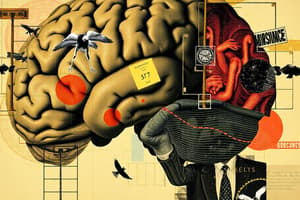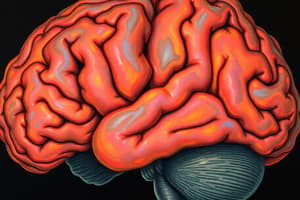Podcast
Questions and Answers
Where do the pyramidal motor tracts originate?
Where do the pyramidal motor tracts originate?
- Basal ganglia
- Cerebellum
- Cortex (correct)
- Brainstem
Which motor pathway is responsible for reflex movements?
Which motor pathway is responsible for reflex movements?
- Tectospinal pathway
- Corticospinal pathway
- Vestibulospinal pathway
- Extrapyramidal pathway (correct)
What is the function of the corticospinal tract?
What is the function of the corticospinal tract?
- Facilitates flexor and inhibits extensor motor neurons
- Provides skill, precision, and agility during voluntary movements (correct)
- Initiates and controls precise movements
- Controls posture and axial muscles
Which part of the brain helps maintain posture and balance?
Which part of the brain helps maintain posture and balance?
Where does the rubrospinal tract originate?
Where does the rubrospinal tract originate?
What is the function of the ventromedial motor tracts?
What is the function of the ventromedial motor tracts?
Which motor pathway receives input from the cerebellum and motor cortex?
Which motor pathway receives input from the cerebellum and motor cortex?
What is the primary function of the basal ganglia in motor control?
What is the primary function of the basal ganglia in motor control?
Which type of lesion results in weakness and hyperreflexia?
Which type of lesion results in weakness and hyperreflexia?
Which of the following is a sign of upper motor neuron lesion?
Which of the following is a sign of upper motor neuron lesion?
Which reflex absence suggests an Upper Motor Neuron lesion?
Which reflex absence suggests an Upper Motor Neuron lesion?
What is a suggestive sign of upper motor neuron lesion if present?
What is a suggestive sign of upper motor neuron lesion if present?
What is a characteristic of Lower Motor Neuron lesions?
What is a characteristic of Lower Motor Neuron lesions?
What is a characteristic sign of lower motor neuron lesion?
What is a characteristic sign of lower motor neuron lesion?
Which condition affects the alpha motor neurons in children?
Which condition affects the alpha motor neurons in children?
Which condition is caused by a virus affecting the alpha motor neurons in children?
Which condition is caused by a virus affecting the alpha motor neurons in children?
What is the result of injury to Lower Motor Neurons?
What is the result of injury to Lower Motor Neurons?
What is the role of the corticospinal tract on alpha motor neurons?
What is the role of the corticospinal tract on alpha motor neurons?
Where does a lesion above the decussation of the corticospinal tract lead to weakness?
Where does a lesion above the decussation of the corticospinal tract lead to weakness?
What is the result of injury to lower motor neurons?
What is the result of injury to lower motor neurons?
What is a characteristic of Upper Motor Neuron lesion signs?
What is a characteristic of Upper Motor Neuron lesion signs?
What is a characteristic sign of upper motor neuron lesion in the brain or brainstem?
What is a characteristic sign of upper motor neuron lesion in the brain or brainstem?
What plays a large inhibitory role on alpha motor neurons?
What plays a large inhibitory role on alpha motor neurons?
What is a possible sign of lower motor neuron lesion involving several levels of the cord?
What is a possible sign of lower motor neuron lesion involving several levels of the cord?
Which motor tract is responsible for voluntary movements and originates in the cortex?
Which motor tract is responsible for voluntary movements and originates in the cortex?
Which motor tract facilitates flexor and inhibits extensor motor neurons?
Which motor tract facilitates flexor and inhibits extensor motor neurons?
Which part of the brain helps establish muscle tone and integrate semi-voluntary automatic movements?
Which part of the brain helps establish muscle tone and integrate semi-voluntary automatic movements?
Which motor pathway includes synapses in basal ganglia, thalamus, reticular formation, and cerebellum?
Which motor pathway includes synapses in basal ganglia, thalamus, reticular formation, and cerebellum?
Which motor neuron type is considered the 'Final Common Pathway'?
Which motor neuron type is considered the 'Final Common Pathway'?
Which motor tract originates in the red nucleus of the midbrain?
Which motor tract originates in the red nucleus of the midbrain?
Which motor tract is responsible for controlling posture and axial muscles?
Which motor tract is responsible for controlling posture and axial muscles?
Which motor pathway provides skill, precision, fractionation, speed, and agility during voluntary movements?
Which motor pathway provides skill, precision, fractionation, speed, and agility during voluntary movements?
Which tract originates in the superior colliculus of midbrain?
Which tract originates in the superior colliculus of midbrain?
Which tract stimulates flexors and inhibits extensors?
Which tract stimulates flexors and inhibits extensors?
Which tract stimulates extensors and has an ipsilateral effect?
Which tract stimulates extensors and has an ipsilateral effect?
Which descending tract originates in the reticular formation and influences posture?
Which descending tract originates in the reticular formation and influences posture?
Which neurons influence lower motor neurons and originate in the motor cortex and brain stem nuclei?
Which neurons influence lower motor neurons and originate in the motor cortex and brain stem nuclei?
Which signs are characteristic of lower motor neuron lesions?
Which signs are characteristic of lower motor neuron lesions?
Which type of reflex is monosynaptic and involves deep tendon stimulation?
Which type of reflex is monosynaptic and involves deep tendon stimulation?
Which tract originates in the hypothalamus and terminates on preganglionic neurons?
Which tract originates in the hypothalamus and terminates on preganglionic neurons?
Which tract originates in the nucleus of the tractus solitarius and medullary reticular formation?
Which tract originates in the nucleus of the tractus solitarius and medullary reticular formation?
Which type of reflex testing is an easy way to screen test the nerve and/or cord?
Which type of reflex testing is an easy way to screen test the nerve and/or cord?
Which signs are characteristic of upper motor neuron lesions?
Which signs are characteristic of upper motor neuron lesions?
Which descending tract is responsible for reflex head movements in response to visual, auditory, and cutaneous stimuli?
Which descending tract is responsible for reflex head movements in response to visual, auditory, and cutaneous stimuli?
Which tract originates in the superior colliculus of midbrain?
Which tract originates in the superior colliculus of midbrain?
Which tract stimulates extensors (extensor bias) and inhibits flexors ipsilaterally?
Which tract stimulates extensors (extensor bias) and inhibits flexors ipsilaterally?
Which tract originates from the vestibular nuclei to anterior horn length of the cord, ipsilaterally?
Which tract originates from the vestibular nuclei to anterior horn length of the cord, ipsilaterally?
Which descending tract originates from the reticular formation and terminates in the dorsal horn, influencing the endogenous analgesic system?
Which descending tract originates from the reticular formation and terminates in the dorsal horn, influencing the endogenous analgesic system?
Which neurons influence lower motor neurons and originate in the motor cortex and brain stem nuclei?
Which neurons influence lower motor neurons and originate in the motor cortex and brain stem nuclei?
Which reflex is monosynaptic and involves deep tendon reflex and myotactic reflex?
Which reflex is monosynaptic and involves deep tendon reflex and myotactic reflex?
Which reflex testing can be done on most muscles but typical ones are checked clinically, such as Biceps – C5 and Patellar – L4?
Which reflex testing can be done on most muscles but typical ones are checked clinically, such as Biceps – C5 and Patellar – L4?
Which type of lesion produces characteristic signs such as spasticity, hyper-reflexia, and decreased/absent superficial reflexes?
Which type of lesion produces characteristic signs such as spasticity, hyper-reflexia, and decreased/absent superficial reflexes?
Which neurons form the final common pathway to skeletal muscle?
Which neurons form the final common pathway to skeletal muscle?
Which sign is typically associated with lower motor neuron lesions?
Which sign is typically associated with lower motor neuron lesions?
Which motor system level, side, and specific structures are typically checked during motor exam for identifying lesions or dysfunctions?
Which motor system level, side, and specific structures are typically checked during motor exam for identifying lesions or dysfunctions?
Which nervous system does the Hypothalamus control?
Which nervous system does the Hypothalamus control?
Flashcards are hidden until you start studying
Study Notes
Motor Control and Reflexes
- The pyramidal motor tracts originate in the primary motor cortex.
- The spinocerebellar tract is responsible for reflex movements.
- The corticospinal tract, also known as the pyramidal tract, is responsible for voluntary movements and originates in the cortex.
- The cerebellum helps maintain posture and balance.
- The rubrospinal tract originates in the red nucleus of the midbrain.
- The ventromedial motor tracts facilitate flexor and inhibit extensor motor neurons.
- The corticospinal tract receives input from the cerebellum and motor cortex.
- The basal ganglia play a large inhibitory role on alpha motor neurons and help regulate motor control.
Upper and Lower Motor Neuron Lesions
- Upper motor neuron lesions result in weakness, hyperreflexia, and spasticity.
- Signs of upper motor neuron lesions include hyperreflexia, clonus, and a positive Babinski sign.
- A characteristic sign of upper motor neuron lesions is a positive Babinski sign.
- Lower motor neuron lesions result in weakness, atrophy, and fasciculations.
- Signs of lower motor neuron lesions include weakness, atrophy, fasciculations, and decreased or absent deep tendon reflexes.
Alpha Motor Neurons and Reflexes
- Alpha motor neurons are responsible for transmitting signals from the central nervous system to muscles.
- The corticospinal tract has an excitatory effect on alpha motor neurons.
- Injury to lower motor neurons results in weakness, atrophy, and fasciculations.
- Polio is a condition that affects alpha motor neurons in children, caused by a virus.
Other Motor Tracts and Pathways
- The tectospinal tract originates in the superior colliculus of the midbrain and is responsible for reflex head movements.
- The vestibulospinal tract originates in the vestibular nuclei and terminates on preganglionic neurons, influencing posture and balance.
- The reticulospinal tract originates in the reticular formation and influences posture and axial muscles.
Reflex Testing
- Deep tendon reflex testing is a way to screen test the nerve and/or cord.
- Reflex testing can be done on most muscles, but typical ones are clinically checked, such as biceps (C5) and patellar (L4) reflexes.
Studying That Suits You
Use AI to generate personalized quizzes and flashcards to suit your learning preferences.




